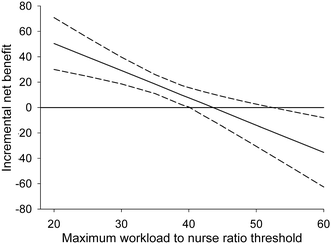Are high nurse workload/staffing ratios associated with decreased survival in critically ill patients? A cohort study
- PMID: 28466462
- PMCID: PMC5413463
- DOI: 10.1186/s13613-017-0269-2
Are high nurse workload/staffing ratios associated with decreased survival in critically ill patients? A cohort study
Abstract
Background: Despite the central role of nurses in intensive care, a relationship between intensive care nurse workload/staffing ratios and survival has not been clearly established. We determined whether there is a threshold workload/staffing ratio above which the probability of hospital survival is reduced and then modeled the relationship between exposure to inadequate staffing at any stage of a patient's ICU stay and risk-adjusted hospital survival.
Methods: Retrospective analysis of prospectively collected data from a cohort of adult patients admitted to two multi-disciplinary Intensive Care Units was performed. The nursing workload [measured using the Therapeutic Intervention Scoring System (TISS-76)] for all patients in the ICU during each day to average number of bedside nurses per shift on that day (workload/nurse) ratio, severity of illness (using Acute Physiology and Chronic Health Evaluation III) and hospital survival were analysed using net-benefit regression methodology and logistic regression.
Results: A total of 894 separate admissions, representing 845 patients, were analysed. Our analysis shows that there was a 95% probability that survival to hospital discharge was more likely to occur when the maximum workload-to-nurse ratio was <40 and a more than 95% chance that death was more likely to occur when the ratio was >52. Patients exposed to a high workload/nurse ratio (≥52) for ≥1 day during their ICU stay had lower risk-adjusted odds of survival to hospital discharge compared to patients never exposed to a high ratio (odds ratio 0.35, 95% CI 0.16-0.79).
Conclusions: Exposing critically ill patients to high workload/staffing ratios is associated with a substantial reduction in the odds of survival.
Keywords: Critical care; Nurses; Personnel staffing; Workload.
Figures
References
-
- Checkley W, Martin GS, Brown SM, Chang SY, Dabbagh O, Fremont RD, et al. Structure, process, and annual ICU mortality across 69 centers: United States Critical Illness and Injury Trials Group Critical Illness Outcomes Study. Crit Care Med. 2014;42:344–356. doi: 10.1097/CCM.0b013e3182a275d7. - DOI - PMC - PubMed
LinkOut - more resources
Full Text Sources
Other Literature Sources



